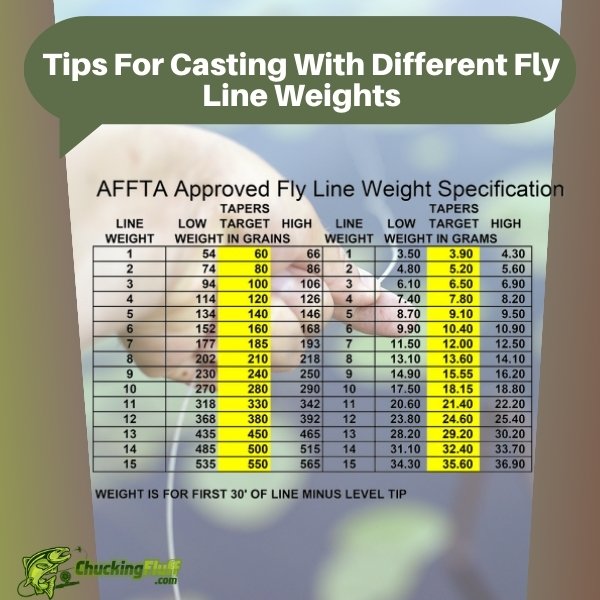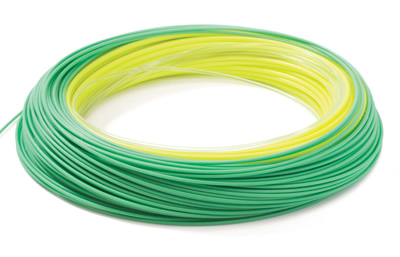| Disclosure: Just to be open and honest the buttons and links you click on in the website will in most cases take you to another website where you can purchase the products I am reviewing. As an Amazon Associate I earn from qualifying purchases. |
Tips For Casting With Different Fly Line Weights

Fly fishing enthusiasts understand the critical role that fly line weight plays in the overall performance of their gear setup. Whether you’re targeting trout in a serene mountain stream or chasing tarpon in the open ocean, selecting the appropriate fly line weight can significantly impact your casting accuracy, distance, and overall fishing success.
Quick Post Navigation
- Introduction to Fly Fishing and Fly Line Weights
- Understanding Fly Line Weight Rating
- Choosing the Right Fly Line Weight
- Tips for Casting with Lighter Fly Line Weights (3wt to 5wt)
- Techniques for Casting with Medium Fly Line Weights (6wt to 7wt)
- Strategies for Casting with Heavier Fly Line Weights (8wt to 9wt)
- Adjusting Casting Stroke and Timing
- Choosing the Right Fly Rod Action
- Using Different Casting Techniques
- Understanding Line Tapers and Their Impact
- Importance of Leader and Tippet Matching
- Handling Different Fishing Scenarios
- Maintenance Tips for Fly Lines
- Common Casting Mistakes and How to Correct Them
- Conclusion
- FAQs
- “Check out some of our other Buying Guides”
Introduction to Fly Fishing and Fly Line Weights
Fly fishing is not just a sport but an art form, where precision and finesse can make all the difference between a successful catch and a day of near misses. Central to this art is the concept of fly line weight, which determines the casting ability and presentation of your fly to the fish.
Understanding Fly Line Weight Rating
The fly line weight rating system categorizes lines into various classes, typically ranging from 1wt to 12wt and beyond. This rating corresponds to the weight of the first 30 feet of the fly line, excluding the leader. A lighter weight, such as a 3wt or 4wt, is suitable for delicate presentations on small waters, while heavier weights like 8wt and 9wt are designed for casting larger flies and handling tougher conditions.
Choosing the Right Fly Line Weight
Selecting the correct fly line weight depends on several factors, including the target species, fishing environment, and casting preferences. For instance, lighter weights are ideal for small trout streams where precision and delicacy are paramount, whereas heavier weights excel in saltwater fishing against strong winds and large fish species.
Tips for Casting with Lighter Fly Line Weights (3wt to 5wt)
When casting with lighter fly line weights, finesse is key. These lines are designed for delicate presentations and are best suited for calm conditions and smaller flies. Utilizing a smooth casting stroke and adjusting your timing to load the rod correctly will help achieve accurate and graceful casts.
Techniques for Casting with Medium Fly Line Weights (6wt to 7wt)
Medium-weight fly lines strike a balance between finesse and power, making them versatile for various fishing scenarios. To optimize casting with these weights, focus on maintaining a consistent casting tempo and adjusting for moderate wind conditions. This ensures both accuracy and distance when presenting your fly.
Strategies for Casting with Heavier Fly Line Weights (8wt to 9wt)
Heavier fly lines are built for casting larger flies and handling adverse weather conditions. When using 8wt or 9wt lines, mastering techniques like double hauling becomes crucial for generating line speed and overcoming wind resistance. Adjusting your casting stroke to accommodate the heavier line weight will enhance your ability to cast long distances with accuracy.
Adjusting Casting Stroke and Timing
Each fly line weight requires a slightly different casting approach. Lighter lines demand a gentler stroke, while heavier lines benefit from a more assertive casting motion. Timing your cast to coincide with the rod’s loading phase maximizes energy transfer, resulting in more efficient and powerful casts.
Choosing the Right Fly Rod Action
Matching your fly rod’s action to the line weight enhances casting performance. Fast-action rods provide greater power and distance with heavier lines, whereas slower-action rods excel in delicate presentations with lighter lines. Understanding rod action ensures optimal casting efficiency across different fly line weights.
Using Different Casting Techniques
Mastering various casting techniques expands your versatility as an angler. Roll casts are effective with heavier lines or when casting under obstacles, while single and double hauls increase line speed and casting distance. Choosing the right technique based on your fishing scenario improves casting efficiency and overall success.
Understanding Line Tapers and Their Impact
The taper design of a fly line influences its casting ability and presentation. Long tapers offer delicate deliveries, ideal for dry flies and small streams, while weight-forward tapers enhance distance and accuracy with larger flies. Selecting the appropriate taper ensures optimal fly presentation tailored to your fishing environment.
Importance of Leader and Tippet Matching
The leader and tippet play crucial roles in fly fishing by connecting the fly line to the fly. Matching the leader and tippet diameter to the fly line weight promotes seamless energy transfer during casting, resulting in improved turnover and natural fly presentation to wary fish.
Handling Different Fishing Scenarios
Fly fishing environments vary widely, from tranquil freshwater streams to challenging saltwater flats. Adapting your gear setup to these scenarios involves selecting the appropriate fly line weight and adjusting casting techniques accordingly. Understanding the nuances of each environment enhances your ability to connect with fish under diverse conditions.
Maintenance Tips for Fly Lines
Regular maintenance extends the lifespan and performance of your fly lines. Cleaning lines after each outing removes dirt and debris that can impair casting performance. Proper storage in cool, dark places protects lines from UV damage and prolongs their effectiveness on the water.
Common Casting Mistakes and How to Correct Them
Even experienced anglers encounter casting challenges. Identifying common errors like tailing loops or improper timing allows for targeted improvement through corrective techniques. Adjusting your casting mechanics and seeking feedback from fellow anglers enhance overall casting proficiency and fishing enjoyment.
Conclusion
Mastering the art of casting with different fly line weights elevates your fly fishing experience from ordinary to exceptional. By understanding the nuances of each weight class, refining your casting technique, and adapting to various fishing scenarios, you can consistently deliver accurate presentations and increase your chances of hooking into prized fish.
FAQs
What is the best fly line weight for trout fishing?
Answer: For small to medium-sized trout in rivers or lakes, a 4wt or 5wt fly line is typically ideal due to their balance of delicacy and casting ability.
Can I use a heavier fly line weight than recommended for my rod?
Answer: While it’s possible, using a significantly heavier line may overload your rod and affect casting performance negatively.
How does fly line weight affect fly presentation?
Answer: Lighter weights allow for delicate presentations, while heavier weights facilitate casting larger flies and overcoming wind resistance.
What are the advantages of double hauling when casting heavier fly lines?
Answer: Double hauling increases line speed, allowing for longer casts and better control, particularly in windy conditions.
Why is it important to match leader and tippet to the fly line weight?
Answer: Matching ensures smooth energy transfer during casting, resulting in better fly turnover and presentation accuracy.
This comprehensive guide equips you with essential knowledge and practical tips to enhance your fly casting skills across different fly line weights. Whether you’re a beginner exploring light streams or a seasoned angler tackling challenging saltwater environments, mastering these techniques will undoubtedly improve your overall fly fishing experience.


